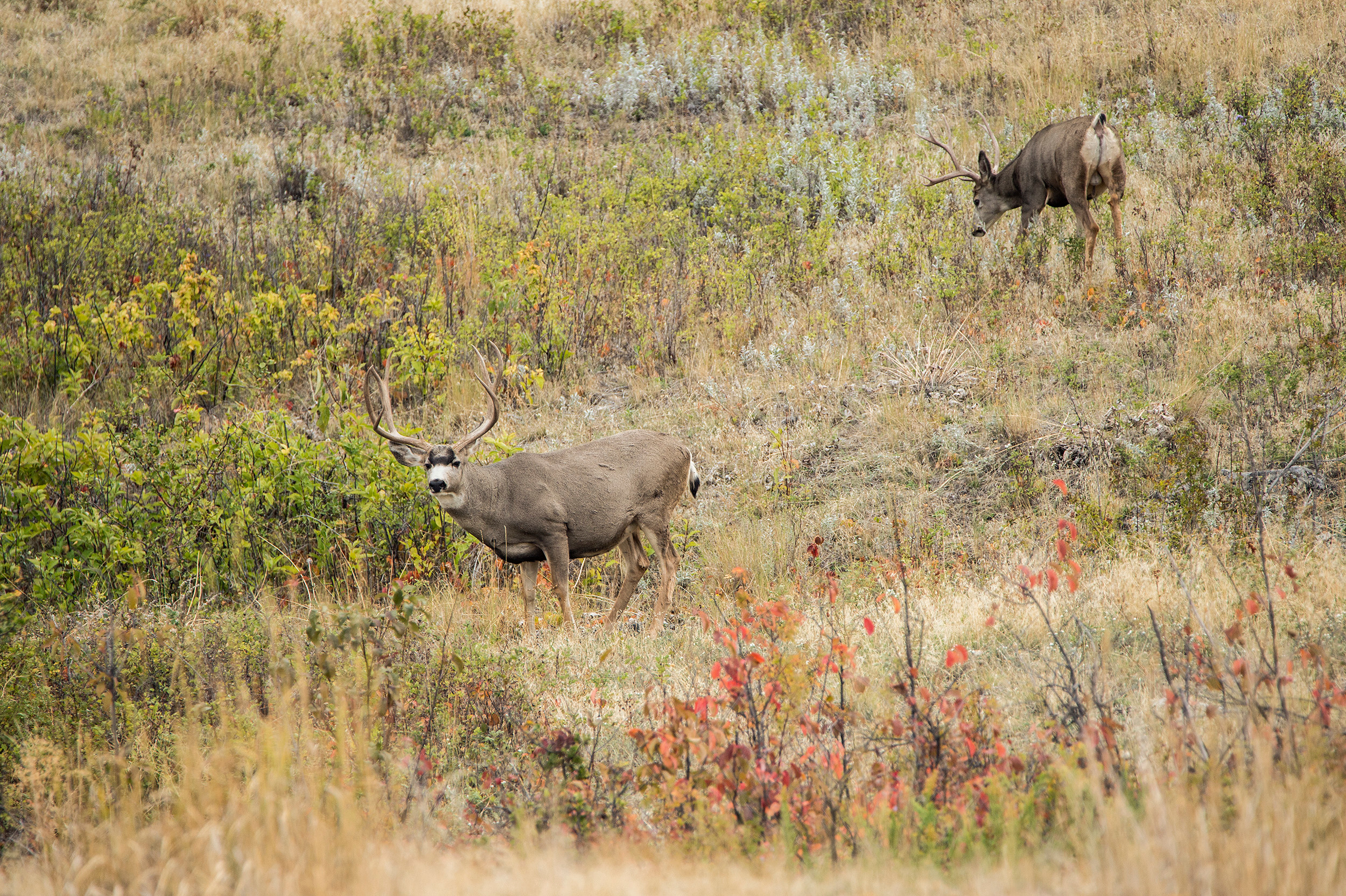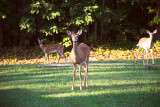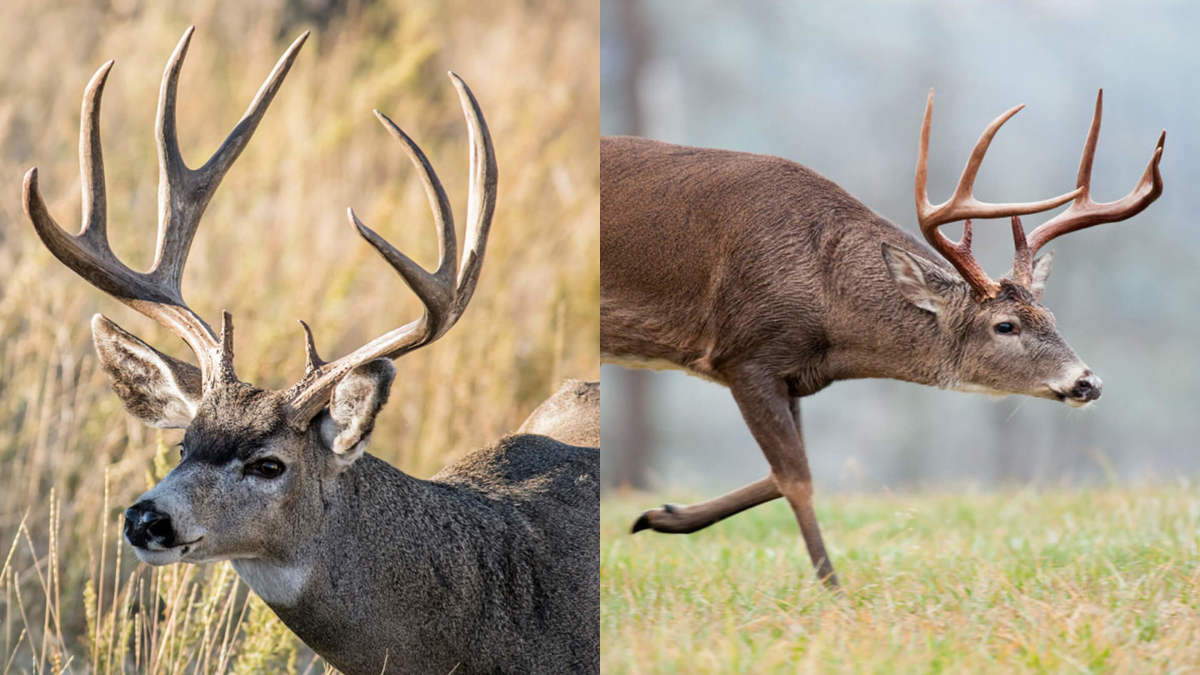
Like many hunters, my early big game experience revolved around the whitetail deer that live on small farms and woodlots throughout the eastern United States. Later, when I moved west to Colorado, I became a die-hard lover of mule deer and the rugged, mountainous country where they live.
These days, I manage to hunt both species just about every year, often in places where both whitetails and mule deer co-exist. While there’s some general similarities, shared behavioral traits, and habitat overlaps between two of America’s most popular big game species, they are very different animals.
Physical Characteristics
A hunter who has only hunted one species or the other might have trouble distinguishing whitetails from mule deer in areas where both are present. From a distance, they look pretty similar to one another. Physically, however, there’s some pretty distinguishing features that separate whitetails from mule deer.
Body Size and Color
Tiny subspecies like the Keys deer or Coues deer aside, whitetails vary widely in average body size across their range, from small-bodied south Texas deer to giant three-hundred pound Saskatchewan bucks. Whitetails in northern latitudes grow much larger than their southern cousins. This phenomena is known as Bergmann’s principle, which doesn’t seem to have nearly as much influence on mule deer body size.
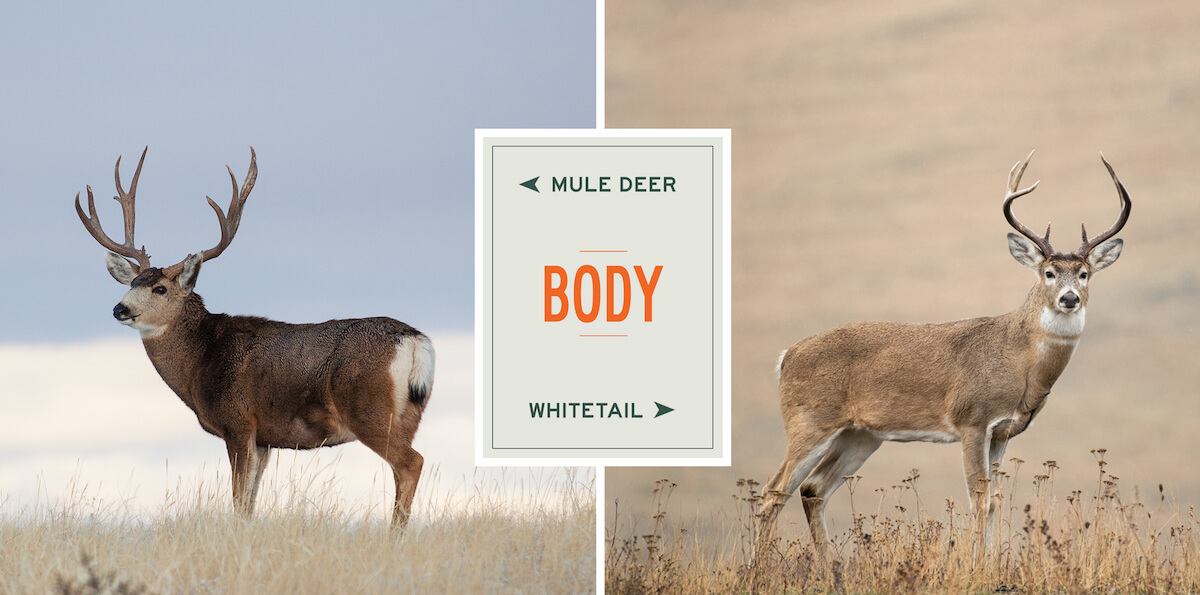
Generally speaking, the average midwestern whitetail buck is smaller-bodied than the average Rocky Mountain mule deer buck of the same age. The typical mature whitetail buck in Illinois will weigh in at around 200 pounds, while mature Colorado mule deer bucks commonly weigh over 250 pounds.
Mule deer and whitetails have slightly different color patterns as adults. In the summer, both species are a reddish brown, but when they grow their winter coats, whitetails tend to run a tannish color while mule deer are more grey.

Antler Size and Shape
Mule deer antlers are also generally larger than a whitetail’s, which is more than likely related to the fact that antlers are primarily a sexual display ornament like a male salmon’s toothy kyped jaw or a male lion’s mane. Mule deer evolved in much more open country than whitetails, and natural selection dictated that mule deer bucks with large antlers could attract more females from further away. Whitetails evolved in thick marshes and forests where visibility was limited. Big antlers and long-range attraction was unnecessary.
Another major difference is how their antlers are configured. On whitetails single tines sprout from a main beam, with the prototypical mature buck having four or five points, including the “eye guard” or brow tine, on each side. Mule deer have “bifurcated” antlers, with tines that fork above the main beam. Most mature mule deer bucks have two forks and four points plus a brow tine on each side, but antler configuration can differ widely among individual animals of both species.
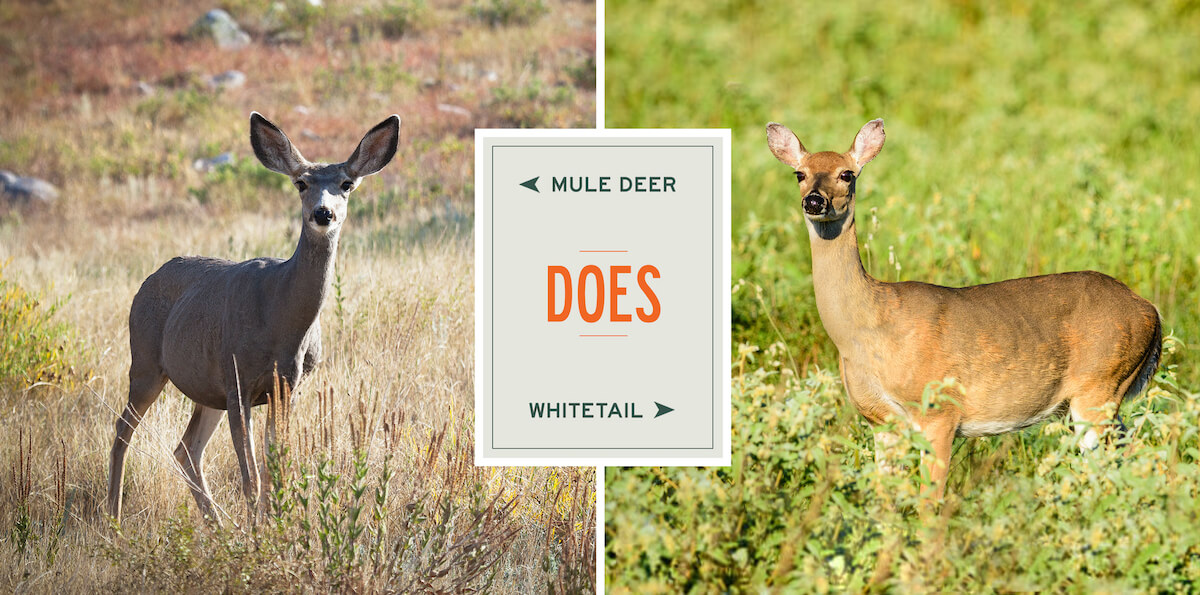
Ear Size
Mule deer got their name from the relatively large size of their “mule-like” ears. It’s thought that their large ears are an evolutionary trait that allows them to more easily dissipate body heat in hot desert environments. It’s not uncommon to see mule deer in colder climates with chunks of their ears missing due to frostbite. Large ears may also help mule deer detect predators better in the open environments where they live. I know I’ve been busted by muleys hundreds of yards away by making the slightest noise on calm days.
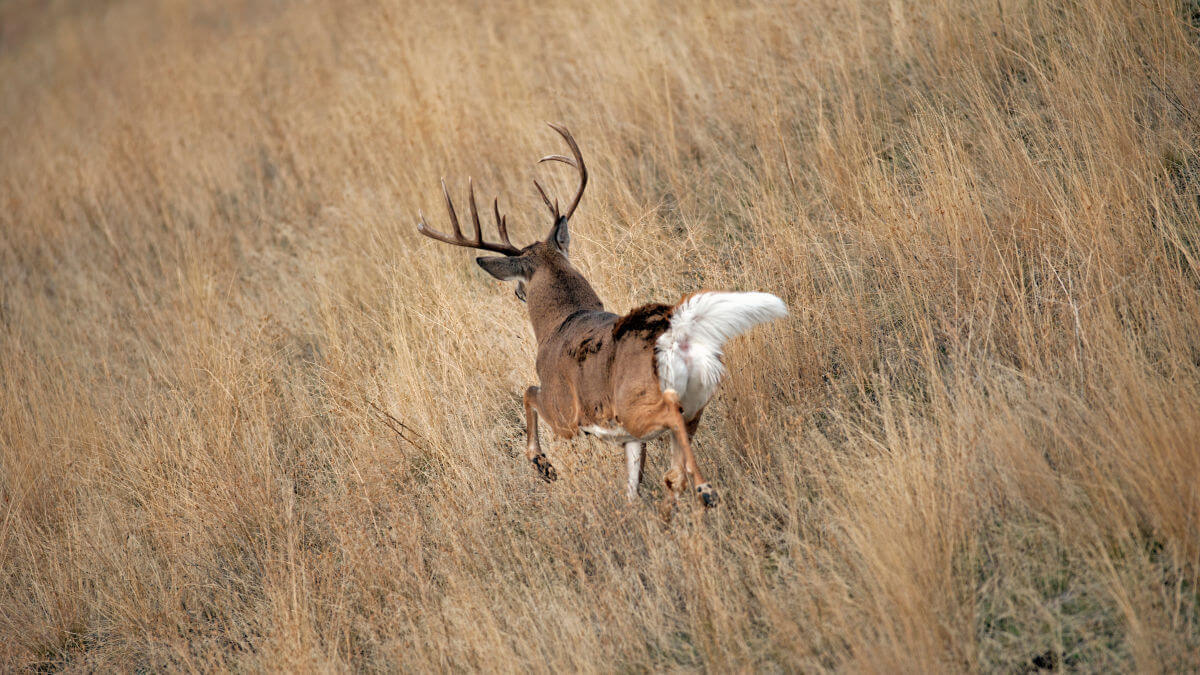
Tails
One of the most iconic images in hunting is a whitetail buck bounding away from a hunter with his bright white tail held high. There’s a lot of theories behind why whitetails evolved this “flagging” display system. Some believe it is a warning to other deer. Others think it might be some kind of distraction to predators, and still others have suggested that does use it to make sure their fawns can follow them easily while fleeing danger. Whatever the case, for deer hunters, a white flag bouncing away through the woods is never a good sign.
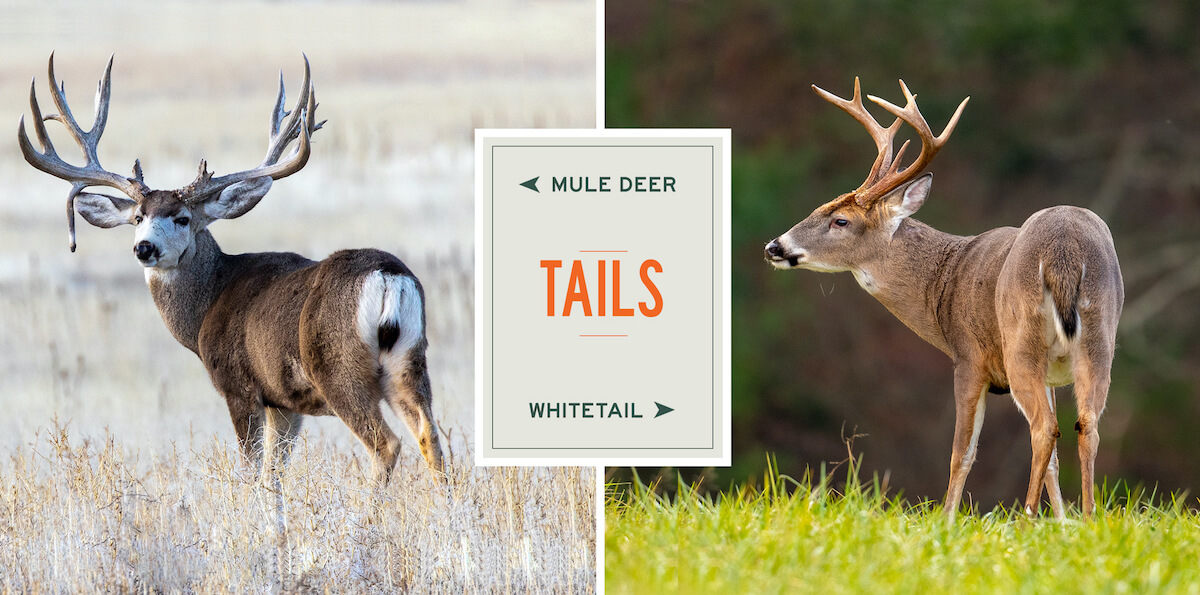
Mule deer lack the large, brightly colored tail found on whitetails. Their tail is a thin, short rope with a black tip. Their large rump, though, is much lighter in color than the rest of their body. It’s unclear how or if it’s used for display purposes, but it sure makes them easier to spot on a distant hillside.
On the other hand, whitetails have a darker rump than muleys (except for when their tail is up). Both tails can have black tips, so the primary characteristic that differentiates the species is tail shape.
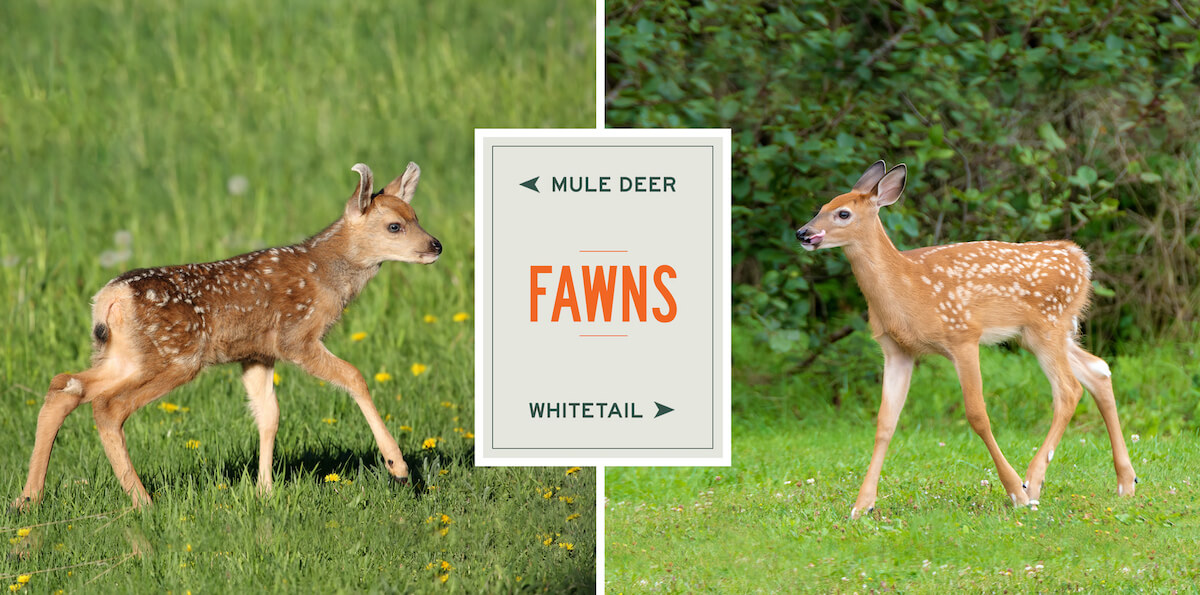
Fawns
Whitetail and muley fawns are almost identical for the first few months of their life. It won’t be until they start to lose their spots that it becomes obvious which is which. At that point, their tails should be more defined, as well as how they run.
Evolution and History
Whitetail deer are the world’s “oldest” deer species; they’ve been around in basically the same form for nearly 4 million years. Mule deer, on the other hand, are considered the world’s “youngest” deer species, having evolved into their current form as a post-glacial species only 10 thousand years ago. Despite this giant disparity in the age of each species, these two deer are closely linked to one another.
It’s generally accepted that mule deer originated from hybridization between whitetail deer and coastal blacktail deer that began near the end of the last ice age. Whitetail deer were a creature of warmer climates. They expanded their range from their original habitat in what is now the southeastern United States, across the southern portion of the country below the ice sheet towards California. Here, they mingled with blacktail deer whose ancestors migrated from southeast Alaska, south down the Pacific coast during the ice age.
Over a period of hundreds, possibly thousands of years and generation after generation of hybridization, mule deer emerged as a new deer species. As the ice age ended and the glaciers receded northwards, mule deer took advantage of new available habitat, habitat for which they were specially adapted.
Dr. Valerius Geist, one of the world’s foremost experts on deer ecology, says this in his book Deer of the World: “This happened most likely during the ecological turmoil of megafaunal extictions 11,000 to 9,000 years ago. Freed from severe competition and predation, the two opportunists species multiplied, radiated, and hybridized. The hybrid evolved as a new form, the mule deer, by adapting to climatically more extreme, open landscapes…”
This book is a fascinating, in-depth read for anyone interested in deer found around the globe.
Populations, Distribution, and Habitat
To put it simply, whitetails are just about everywhere and there’s a lot of them. Meanwhile, the overall range of mule deer is smaller and their numbers significantly lower. In some places, whitetails and mule deer are found side-by-side, whether that’s in an irrigated alfalfa field in western Kansas or a remote canyon in eastern Washington. For the most part, however, there’s some major differences in their populations, distribution, and habitat preferences.
Whitetails are now found in nearly all of the continental United States. California and Nevada are the exceptions for the time being, but whitetails are constantly expanding their range into new areas. They’re also common in several Canadian provinces, with a northern limit near the arctic circle in the Yukon Territory. Southward, whitetails extend into Mexico and the tropical jungles of Central and South America. In the U.S. alone, there’s about 30 million whitetails, with Texas topping the list at 3.6 million. We have more whitetails now, by far, than at the time of European contact.
Mule deer range is more limited than whitetails, but they’re found from the deserts of Mexico in the south, all the way north into the remote mountains of British Columbia and the Yukon Territory. There’s even recent examples of mule deer showing up in Alaska.
The largest concentration of mule deer populations tend to fall along either side of the Continental Divide, with smaller numbers extending into the central plains. Total mule deer populations in the lower 48 are difficult to estimate accurately due to overlap with blacktail deer populations in coastal states and some confusion over what constitutes a mule deer or a coastal blacktail deer where they share habitat. It’s believed there’s around three and half million of the two species combined. Colorado has the largest population of mule deer with over 400,000 animals.
Whitetails can get by just about anywhere. They are generalists capable of surviving in a variety of habitats from swamps to forests, and plains to mountains. Where the two species differ greatly is the whitetail’s incredible adaptability, which has allowed it to thrive alongside humans. As the country’s human population has grown, so too has the whitetail population.
Agriculture and forest thinning have been a boon to whitetails. Whitetails are found anywhere there’s some cover and food, even suburban neighborhoods and city greenbelts. Riparian corridors and young forests adjacent to crop fields such as corn, wheat, and soybeans are some of the most productive whitetail habitat.
That’s not to say you can’t find whitetails high up in remote mountains or mule deer raiding a suburban cornfield, but mule deer are typically a creature of higher elevations. Unlike whitetails that have thrived because of increased human alteration of the landscape, mule deer do best where humans have had the least amount of impact on their habitat. Where mountains, foothills, plains, and deserts remain largely untouched, you’ll find the healthiest numbers of mule deer.
Behavior
A mule deer’s home range is vastly larger than the average whitetail. A whitetail can easily live its entire life in a single square mile. Wherever they’re found, they rarely travel more than a few miles from their birthplace. Because food resources are plentiful and winters manageable, lowland whitetails don’t need to travel long distances to survive.
In the Rockies, it’s a different story for mule deer. Mule deer often summer in high elevation alpine habitat above the treeline where the richest food sources are found, but because snow levels are unmanageable during winter, mule deer migrate downhill to river valleys and low elevation sagebrush habitat where food is accessible. The distance between those two points may be well over one hundred miles. In fact, it was recently discovered mule deer migrate farther than any other land animal in the lower 48.
Mule deer and whitetails are both primarily browsers as opposed to grazers, like elk. Both species will eat hundreds of different types of plants. Their natural and preferred food sources include an array of forbs and shrubs rather than grass, although in the spring they’ll seek out fresh green grass. In the fall and winter, whitetails feed on waste grain, man-made food plots, acorns and young saplings, while mule deer prefer mountain mahogany, aspen shoots, and sagebrush.
Like a lot of big game animals, mule deer and whitetails are crepuscular, meaning they most actively feed and travel near dawn and dusk. In the middle of the day they bed down to rest and chew their cud. During hunting seasons, whitetails prefer thick, brushy bedding areas, while mule deer often choose shady spots near the tops of ridges where they can survey a large area for danger.
Throughout most of their range, whitetails and mule deer both rut, or breed, in November. Hybridization between the two species can occur, but is rare and the offspring usually don’t survive to adulthood. The peak of the whitetail rut tends to fall during the first week or two of November. Mule deer breeding activity is highest in the second half of November. While whitetail bucks are constantly on the move at this time, they don’t cover nearly as much ground as mule deer bucks during the rut.
This is in large part because they don’t have to. Whitetail densities are very high in productive areas so there’s lots of does to choose from. Mule deer densities are much lower so the bucks travel long distances to find does. They are also much more nomadic than whitetails, and the mule deer rut often coincides with their winter migration.
Mule deer and whitetail both have highly advanced sensory capabilities when it comes to predator and hunter avoidance. Both species have good eyesight when it comes to picking up movement. Personally, I believe mule deer rely on their eyesight more than whitetails and that they see a bit better at long range.
Mule deer may also have a slight advantage when it comes to hearing with those big ears. As far as smell goes, both species of deer rely on their exceptional sense of smell to avoid being eaten or shot at. They trust their noses, even if their eyes and ears haven’t set off a warning bell. The main difference I’ve noticed between spooked whitetails and mule deer is that mule deer often take more time than whitetails to confirm whether something is an actual threat or not.
This makes sense when you consider mule deer live in steep, open country. Confirming whether it’s necessary or not to run a long ways prevents them from wasting valuable calories. Whitetails live in thicker, flatter country so fleeing a short ways into the brush is fast and easy.
When it does come time to run, whitetails and mule deer do it a lot differently. Whitetails run fast, sometimes with a bounding leap to escape predators. Mule trot or gallop more slowly when alarmed, and then stot to escape. Stotting is unique to mule deer, as no other deer species utilizes this stiff-legged, high bouncing gait. Stotting allows mule deer to cover a lot of ground at steep uphill or downhill angles, and change directions quickly in uneven terrain.
When spooked, mule deer have historically gotten a bad rap from hunters for stopping on a vantage point to turn and see if they need to keep going. Whitetails almost never do this, but they’re almost always a quick sprint from cover. Mule deer live in more open terrain, so why keep running if a quick stop and look around proves it’s unnecessary to do so.
As the youngest deer species in the world, it’s possible mule deer haven’t had time to evolve away from this trait. It must work well against coyotes and mountain lions, but it has been the demise of many a mule deer that thought they were out of reach from a human threat. I will add that big, old mule deer bucks rarely give a hunter this opportunity anymore, so maybe they are adjusting to humans carrying high-powered rifles.
Hunting
In general, whitetails can be considered a little more paranoid than mule deer when it comes to hunting pressure, but they’ve got a few million more years of evolutionary experience avoiding predators and thousands of years more experience evading human hunters. Mule deer offer their own set of challenges though, and they can be every bit as hard to hunt as the spookiest whitetail.
Because whitetails are so keyed in to human hunting activities, most whitetail hunters employ ambush and stand hunting tactics to kill them. There’s little argument that it’s the most effective way to hunt whitetails in places like the Midwest, Northeast, and South where the woods are thick and agricultural food sources draw them into the open. Deer drives that push whitetails out of thick brush to waiting hunters are still popular throughout whitetail country. On rare occasions, you can successfully pull off a still hunt in these places, but it’s difficult to say the least.
Some of these tactics are used on occasion by western mule deer hunters. Still hunting works very well for mule deer, but whitetail hunters east of the Mississippi rarely have the opportunity for a spot and stalk hunt. This is the most popular method of mule deer hunting out west. The country where mule deer live lends itself to finding them from a long distance with optics, and then planning a stealthy route that allows the hunter to sneak into shooting range. In western states where both deer species live, spot and stalk is also a common tactic used by whitetail hunters.
Conservation and Management Challenges
Whitetail populations are generally doing well throughout the country, but there’s evidence that populations aren’t as high as they were a couple decades ago. Some of this is intentional on the part of state wildlife managers who are encouraging hunters to harvest more deer, especially does, in areas where whitetail deer densities are extremely high and numbers are above management objectives. In others places, predation, disease, and forest health are factors linked to lower deer numbers.
In the upper midwest, wolf populations are growing enough that it is believed they are having a significant impact on certain deer herds. Elsewhere, where wolves aren’t present, coyotes have moved in to places where they never existed before, filling a predatory void. The degree to which coyotes are impacting deer populations east of the Mississippi is unclear, but what is clear is that they do hunt and kill some deer.
Perhaps the biggest conservation concern for most whitetail hunters is Chronic Wasting Disease (CWD), which seems to be popping up in new areas on a daily basis. CWD is fatal to every deer that contracts it, and unlike diseases like Epizootic Hemorrhagic Disease (EHD), the effects aren’t temporary. Once a deer herd is infected with CWD, the disease is there to stay. The long-term impacts of CWD are still being assessed, but the disease is already impacting whitetail conservation and management strategies all over the country.
CWD is a growing concern for some mule deer hunters as well, but there are even more immediate problems. Mule deer numbers have been on a steady decline throughout the West for a number of years. Earlier I mentioned that Colorado has over 400,000 mule deer; the state supported well over 500,000 just over a decade ago. Theories abound as to why mule deer populations are falling.
It’s likely that several factors, many of which mule deer could withstand on an individual basis, are adding up to a much larger problem. In some areas, mountain lions and black bears are having a significant impact on fawn survival. Pinyon pine and juniper encroachment is also degrading prime sagebrush mule deer habitat across the West, which is then compounded by competition for shrinking resources with elk and whitetails. In critical migration corridors, barriers created by energy extraction are obstructing historical mule deer travel routes. Finally, and perhaps most importantly, unchecked development in mountain valleys throughout the west is carving up mule deer winter range at an alarming rate.
Where development has chewed up mule deer habitat, and winter range in particular, mule deer are suffering. Here in Colorado, mule deer have some of the most productive alpine summer range found anywhere in the country, but in the valleys where the deer need to ride out the winter, there’s less and less space for them. For mule deer, it’s the straw that could break the camel’s back, but it’s not a problem whitetail are likely to face.
Whitetails are America’s favorite big game animal, and for good reason. They’re accessible, abundant and widespread. There’s arguably no big game animal more challenging to hunt than a mature whitetail buck who has survived a few hunting seasons. Whitetails were my first childhood hunting crush and hunting them brings back fond memories.
These days, mule deer are my true love when it comes to big game hunting. Mule deer are the underdog. They are mysterious, here-today gone-tomorrow travelers, that prefer tough, remote environments where people don’t like to go, especially the biggest, oldest bucks that never stop to look back before they slip over the ridge.
Feature image by John Hafner.

